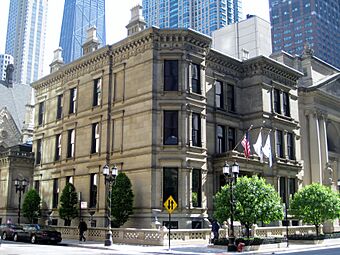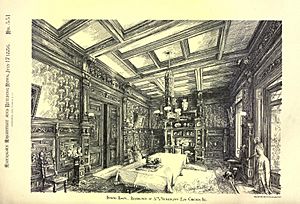Nickerson House facts for kids
|
Nickerson, Samuel, House
|
|

Samuel M, Nickerson House
|
|
| Location | Chicago, IL |
|---|---|
| Built | 1883 |
| Architect | Burling & Whitehouse; Burling, Edward |
| Architectural style | Late Victorian |
| NRHP reference No. | 76000700 |
Quick facts for kids Significant dates |
|
| Added to NRHP | November 7, 1976 |
The Samuel M. Nickerson House is a famous old home in Chicago, Illinois. You can find it in the Near North Side neighborhood. This beautiful house was designed by Edward J. Burling and built in 1883. It was made for Samuel and Mathilda Nickerson. Samuel M. Nickerson was a very important person in the banking world. People said he owned more bank stock than anyone else in the United States at one point.
In 1916, a group of wealthy Chicagoans bought the house. They wanted to save it from being torn down. They gave it to the American College of Surgeons (ACS). The ACS used the house as their main office. They also built a large meeting hall next to it. The house became too small for the ACS, so they started renting it out in 1964. The Nickerson House is listed on the National Register of Historic Places. In 2003, a person named Richard Driehaus bought it. Today, it is the Richard H. Driehaus Museum. This museum shows art and design from the late 1800s and early 1900s.
Contents
Exploring the House's Design
The Nickerson House was designed by Edward J. Burling. He was one of Chicago's first well-known architects. Three different companies helped decorate the inside of the house. These were William August Fiedler, R. W. Bates & Co., and George A. Schastey & Co. The house has three stories and is very large. When it was finished, it was said to be the biggest and most fancy private home in Chicago. Samuel Nickerson spent a lot of money on building and decorating his home.
The outside of the house is made of limestone and Ohio sandstone. It looks elegant but simple. However, the inside is full of amazing details. The house has 17 different types of marble! This is why it was sometimes called the "Marble Palace." It also has onyx, alabaster, and beautiful carved wood. You can see glazed tiles, mosaics, and special wall coverings called Lincrusta.
Most of the original parts of the house are still there. It is a great example of the Aesthetic Movement. This was a style that mixed many different art forms. You can see influences from Japanese, Chinese, English, French, and other cultures. The Nickerson House shows how much people in the Victorian era loved to display beautiful things.
How the House Was Built to Resist Fire
Building the Nickerson House started in 1879. This was soon after the 1871 Great Chicago Fire. That fire led to new rules for building homes with strong materials. The Nickerson House was praised as one of the first truly fireproof homes in the city. Its walls are made of brick and go all the way up to the roof. Underneath the fancy floors, there are brick arches supported by strong iron beams. This design helped protect the house from fire.
The Story of the Nickerson Family
The house was built for Samuel Mayo Nickerson. He helped start the First National Bank in Chicago. He also had businesses in liquor, wine, and explosives during the American Civil War. Samuel Nickerson came from a town called Brewster, Massachusetts. His family was important in shipping and fishing there.
Samuel, his wife Mathilda, and their son Roland lived in the house from 1883 to 1900. They held many fancy parties and events there. They also used the house to show off their amazing art collection. This collection included American and European paintings, drawings, and items from Japan and China. In 1900, the Nickersons gave their art collection to the Art Institute of Chicago.
After the Great Chicago Fire, the Near North Side became a popular area for rich business owners like Nickerson. Many important families lived there. Because the McCormick family had many mansions on Rush Street, the area was known as McCormickville.
In 1900, Samuel Nickerson retired. He sold the house to Lucius George Fisher. Fisher was the president of a paper company. He owned the house until he passed away in 1916. After buying the house, Fisher hired an architect named George Washington Maher. Maher changed Nickerson's art gallery into a trophy room and library. He added a beautiful stained glass dome and new bookshelves.
When Fisher's family decided to sell the house in 1916, people worried it might be torn down. This led to Chicago's first successful effort to save a historic building. A group of important Chicagoans, including William Wrigley Jr. and Julius Rosenwald, raised money to buy the house. In 1919, they gave the house to the American College of Surgeons. The College of Surgeons used the house as their offices until 1965.
The Nickerson House as a Museum
In 2003, Chicago businessman Richard Driehaus bought the house. He worked to restore it to its original beauty. In 2008, he opened it to the public as the Richard H. Driehaus Museum. The museum displays some of the original furniture from the Nickerson family. It also shows Driehaus's own collection of art and objects from the late 1800s and early 1900s. This includes statues, paintings, and beautiful glass pieces by Louis Comfort Tiffany.
Bringing the House Back to Life
When the restoration started in 2003, the building was in good shape. But it was very dirty. One of the biggest jobs was cleaning the outside. The stone on the facade had become very dark from dirt and pollution. It used to be light gray. Instead of using harsh chemicals, they cleaned the outside with lasers! This was the first time an entire building in the United States was cleaned this way. This method is often used in Europe for cleaning statues.
The restoration of the Nickerson House won an award in 2008. It was recognized for its excellent preservation work.
See also
 In Spanish: Casa de Samuel M. Nickerson para niños
In Spanish: Casa de Samuel M. Nickerson para niños







